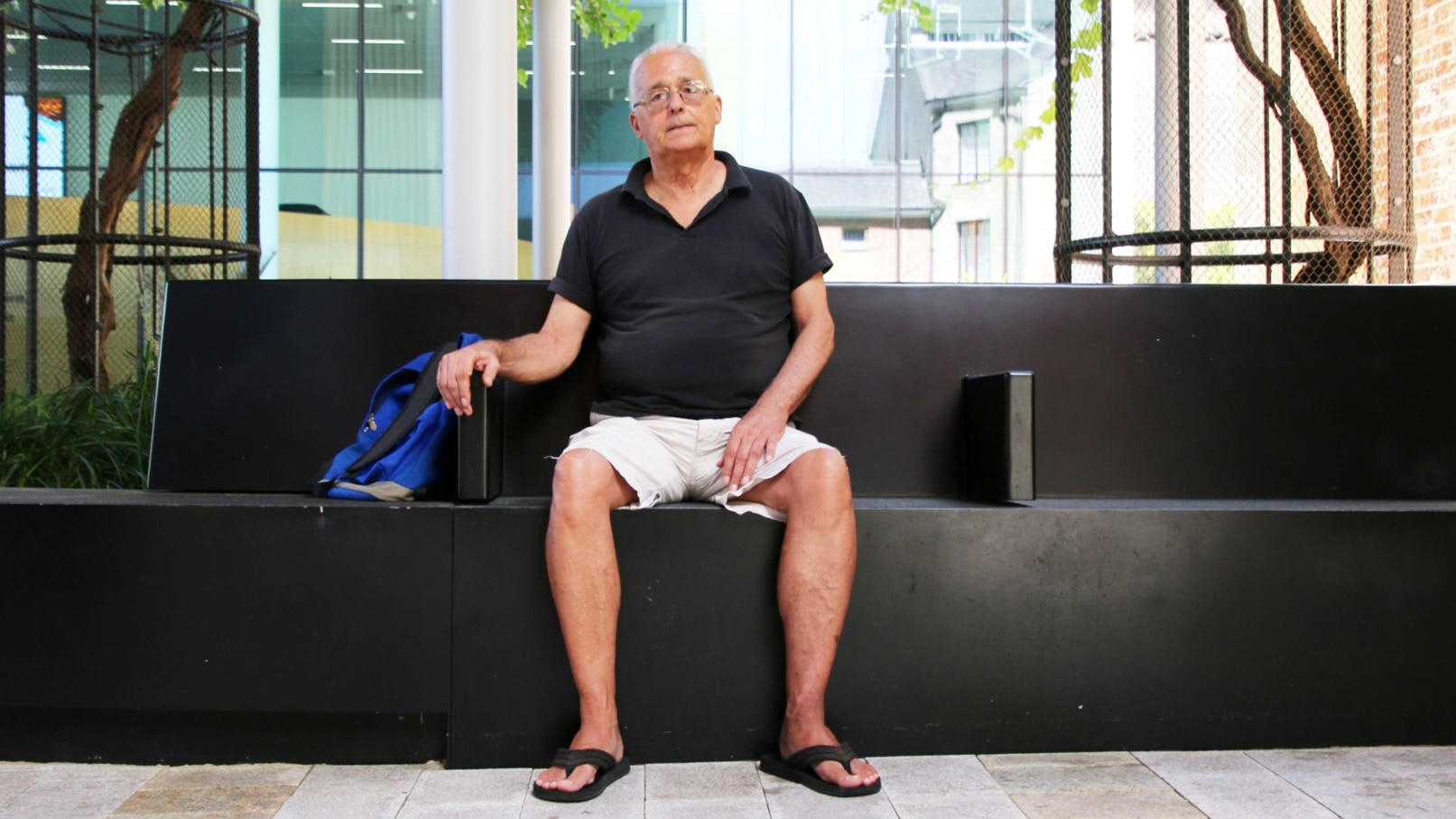
Len James says hostile architecture like this made his life tough when he was sleeping rough. (ABC News: Grace Burmas)
Can the humble park bench be considered hostile? Seems like a silly question.
But for some of the most vulnerable people, the design of public furniture can mean the difference between them feeling safe or not.
Experts say the shapes and designs of seating in the built environment are becoming increasingly hostile and homeless services say it’s one way vulnerable people are being pushed out of cities.
It could be a curve in its design, sharpened edges, or arm rests placed in the middle of the seat.
They are details that make it uncomfortable or impossible to sit for a long time or lie down.
It’s commonly referred to as hostile architecture.
Len’s struggle
For Len James, these design features made the daily battle of finding somewhere to sleep even harder.
He became homeless on the streets of Perth at 58, after a back injury put him out of work.
“In a subtle way they let me know that they didn’t want me there, so I had to look for somewhere else,” Mr James said.
“That’s what it’s like when you’re on the streets, you’re forever looking for somewhere safe where you can sleep at night.”
Mr James is now in social housing but he said feeling rejected by his city sits vividly in his memory.
“When your world becomes very small, things are exaggerated, so these things weigh heavily on you,” he said.
Hostile architecture isn’t limited to the design of benches.
High-pitched ringing in a stairwell, music playing on loop or sprinklers coming on in parks are all ways people can be told to move along.
Creating barriers
Regional Urban Planning Lecturer at Curtin University, Shane Grieve, said these design features are intentional.
“[It’s] all the little design elements that we put into what could be commonplace architecture that actually makes it difficult for people to be there for much longer than they should,” he said.
“The ‘should’ is determined by somebody else.”
Dr Greive said some local governments implement measures to prevent anti-social behaviour but, in doing so, it creates another barrier for people sleeping rough.
“We’re trying to design out crime, and we’re making places more defensible,” he said.
“That works when you’ve got criminals or people with evil intent or bad intent.
“It’s a different matter when you’re using those design capacities or control features to really oppress people who are already very vulnerable and doing it tough.”
Fighting for change
Shelter WA CEO Kath Snell said hostile architecture was a major issue for people sleeping rough, and was not a long-term solution to homelessness.
As an interim measure, the service works with some local governments to advocate for public spaces to be more accessible.
“What we’re trying to do is really encourage people not to just move the problem, that’s not solving anything,” Ms Snell said.
“This is what your hostile architecture is doing.
“What we’re saying to local governments is we’ve all got a part to play in this. Let’s not make life even harder for people who are experiencing rough sleeping.”
What’s the solution?
Ms Snell said a move away from hostile architecture would involve benches designed to be slept on and not turning sprinklers on where councils know people are sleeping at night.
“Let’s look at ways of improving that and changing it and seeing the differences that makes in your community as a whole,” she said.
Mr James said having access to welcoming infrastructure in his city would have made a “world of difference”.
“It would be appreciated so much by people that are homeless that someone cares, that someone has put a bit of thought into it to try and make life a bit easier for them,” he said.
“Ultimately homeless people need a roof over their heads.
“It’s no good sort of giving people move on notices, and just pushing the problem from one place to another.
“It’s a crisis and it needs to be addressed.”
News Related-
High court unanimously ruled indefinite detention was unlawful while backing preventive regime
-
Cheika set for contract extension as another Wallabies head coaching candidate slips by
-
Analysis-West's de-risking starts to bite China's prospects
-
'Beyond a joke' Labor won't ensure PTSD protections: MP
-
Formula One season driver ratings: Lando Norris shines as Max Verstappen nears perfection
-
Catalina golfer Tony Riches scores Guinness World Record four holes in one on same hole
-
Florida coach Billy Napier fires assistants Sean Spencer, Corey Raymond with expected staff shakeup ahead
-
Rohingyan refugee NZYQ accidentally named in documents published by high court
-
Colorado loses commitments of 2 more high school recruits
-
Queensland Health issues urgent patient safety alert over national bacteria outbreak
-
Townsville Community Pantry 'distressed' by fruit, vegetable waste at Aldi supermarket
-
What Is The Beaver Moon And What Does It Mean For You?
-
Labor senator Pat Dodson to resign from politics due to health issues
-
Hamas releases 11 more hostages, as Israel agrees to extend ceasefire
